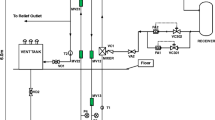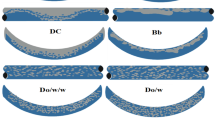Abstract
The mass transfer to turbulent flow through back-to-back pipe bends arranged in a 180° configuration with different lengths of pipe between the bends was measured using a dissolving gypsum test section in water. The measurements were performed for bends with a radius of curvature of 1.5 times the pipe diameter (D) at a Reynolds numbers of 70,000 and Schmidt number of 1280. The maximum mass transfer in the bends decreased from approximately 1.8 times the mass transfer in the upstream pipe when there was no separation distance between the bends to 1.7 times when there was a 1D or 5D length of pipe between the bends. The location of the maximum mass transfer was on the inner sidewall downstream of the second bend when there was no separation distance between the bends. This location changed to the inner wall at the beginning of the second bend when there was a 1D long pipe between the bends, and to the inner sidewall at the end of the first bend when there was a 5D long pipe between the bends.









Similar content being viewed by others
Abbreviations
- ΔC o :
-
Initial concentration difference (g/l)
- C b :
-
Bulk flow concentration (g/l)
- C w :
-
Pipe wall concentration (g/l)
- D m :
-
Gypsum diffusivity in water at 25 °C (m2/s)
- D :
-
Pipe inner diameter (m)
- e :
-
Roughness height (m)
- e/D :
-
Relative roughness
- e + :
-
Relative roughness scale
- h :
-
Mass transfer coefficient (m/s)
- L :
-
Length of pipes between pipe bends (m)
- R c :
-
Pipe bend radius of curvature (m)
- Re :
-
Reynolds number
- Sc :
-
Schmidt number
- Sh :
-
Sherwood number
- t :
-
Experimental time (s)
- x:
-
Local distance along a pipe (m)
- z :
-
Streamwise distance from the start of the first pipe bend (m)
- δ :
-
Local instantaneous pipe surface wear (mm)
- τ m :
-
Modified time (s)
- ρ :
-
Gypsum density (kg/m3)
- θ :
-
Pipe circumferential angle (°)
- ϕ :
-
Angle along pipe bend (°)
- 1 :
-
First pipe bend
- 2 :
-
Second pipe bend
- d:
-
Downstream pipe
- i:
-
Intermediate pipe
References
Uchida S, Naitoh M, Okada H, Suzuki H, Koikari S, Koshizuka S, Lister DH (2012) Key parameters to determine wall thinning due to flow accelerated corrosion. ECS Trans 25:77–90
Pietralik JM (2012) The role of flow in flow-accelerated corrosion under nuclear power plant conditions. E-J Adv Maint 4:63–78
Achenbach E (1976) Mass transfer from bends of circular cross section to air. Future energy production systems, vol 1. Academic Press, New York, pp 327–337
Wilkin SJ, Oates HS, Coney MWE (1983) Mass transfer in straight pipes and 90̊ bends measured by the dissolution of plaster. Technology Planning and Research Division, Central Electricity Research Laboratories
Mazhar H, Ewing D, Cotton JS, Ching CY (2013) Experimental investigation of mass transfer in 90° pipe bend using a dissolvable wall technique. Int J Heat Mass Transf 65:280–288
Coney MWE (1981) Erosion corrosion: the calculation of mass transfer coefficients. CEGB Rep RD L N 197:80
Sprague PJ, Patrick MA, Wragg AA, Coney MWE (1985) Mass transfer and erosion corrosion on pipe bends. In: Proceedings 8th European Corrosion Conference, Nice, vol I
Poulson B, Robinson R (1988) The local enhancement of mass transfer at 180° bends. Int J Heat Mass Transf 31:1289–1297
Tunstall MJ, Harvey JK (1968) On the effect of a sharp bend in a fully developed turbulent pipe-flow. J Fluid Mech 34(3):595–608
Enayet MM, Gibson MM, Yianneskis M (1982) Laser Doppler measurements for laminar and turbulent flow in pipe bend. Int J Heat Fluid Flow 3:213–220
Rutten F, Schroder W, Meinke M (2005) Large-eddy simulation of low frequency oscillations of the dean vortices in turbulent pipe bend flows. Phys Fluids 17:035107
Hellstrom LHO, Zlatinov MB, Cao G, Smits AJ (2013) Turbulent pipe flow downstream of a 90° bend. J Fluid Mech 735:R7
Mazhar H, Ewing D, Cotton JS, Ching CY (2014) Mass transfer in dual pipe bends arranged in an S-configuration. Int J Heat Mass Transf 71:747–757
Le T, Ewing D, Schefski C, Ching CY (2014) Mass transfer in back to back bends arranged in an out of plane configuration. Nucl Eng Des 270:209–216
Poulson B (1993) Advances in understanding hydrodynamic effects on corrosion. Corros Sci 35:655–665
Dawson DA, Trass O (1972) Mass transfer at rough surfaces. Int J Heat Mass Transf 15:1317–1336
Zhao W, Trass O (1997) Electrochemical mass transfer measurements in rough surface pipe flow: geometrically similar V-shaped grooves. Int J Heat Mass Transf 40:2785–2797
Le T (2013) Mass transfer in back to back elbows arranged in an out of plane configuration under single & annular two-phase flow conditions. Master’s Thesis, McMaster University, Hamilton, Canada
Rowe M (1970) Measurements and computations of flow in pipe bends. J Fluid Mech 43(part 4):771–783
Azzola J, Humphrey JAC, Iacovides H et al (1986) Developing turbulent flow in a U-bend of circular cross-section: measurement and computation. J Fluids Eng 108:214–221
Sudo K, Sumida M, Hibara H (2000) Experimental investigation on turbulent flow through a circular-sectioned 180 bend. Exp Fluids 28:51–57
Sugiyama H, Hitomi D (2005) Numerical analysis of developing turbulent flow in a 180° bend tube by an algebraic Reynolds stress model. Int J Numer Methods Fluids 47(12):1431–1449
Postlethwaite J, Lotz U (1988) Mass transfer at erosion-corrosion roughened surfaces. Can J Chem Eng 66:75–78
Acknowledgments
The support of CANDU Owners Group (COG) and the Natural Sciences and Engineering Research Council of Canada (NSERC) is gratefully acknowledged.
Author information
Authors and Affiliations
Corresponding author
Rights and permissions
About this article
Cite this article
Chen, X., Le, T., Ewing, D. et al. Effect of bend separation distance on the mass transfer in back-to-back pipe bends arranged in a 180° configuration. Heat Mass Transfer 52, 2687–2695 (2016). https://doi.org/10.1007/s00231-016-1774-9
Received:
Accepted:
Published:
Issue Date:
DOI: https://doi.org/10.1007/s00231-016-1774-9




